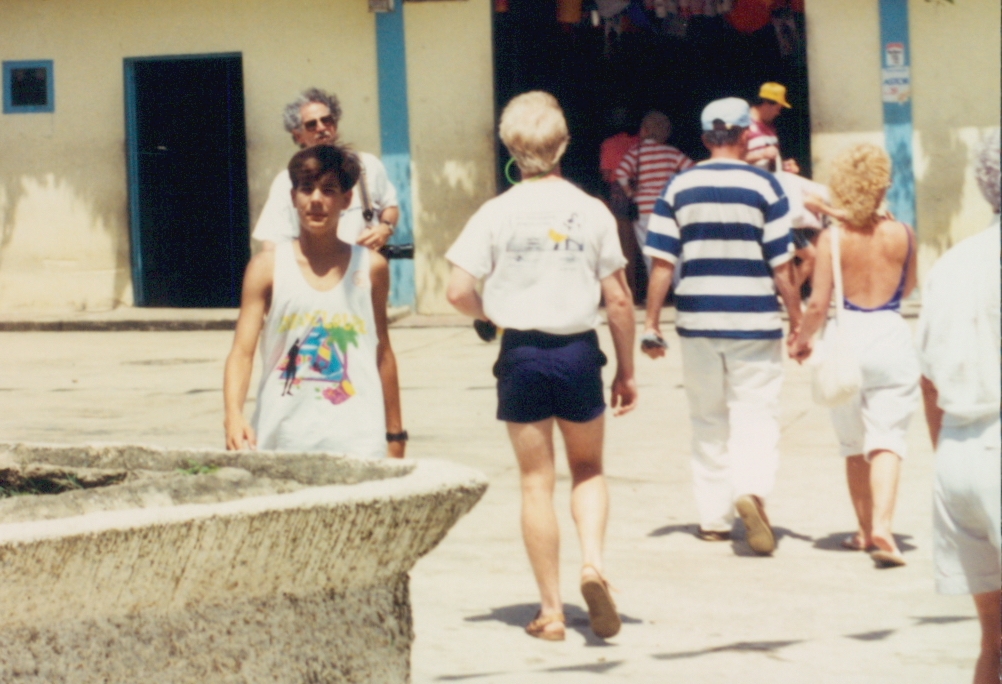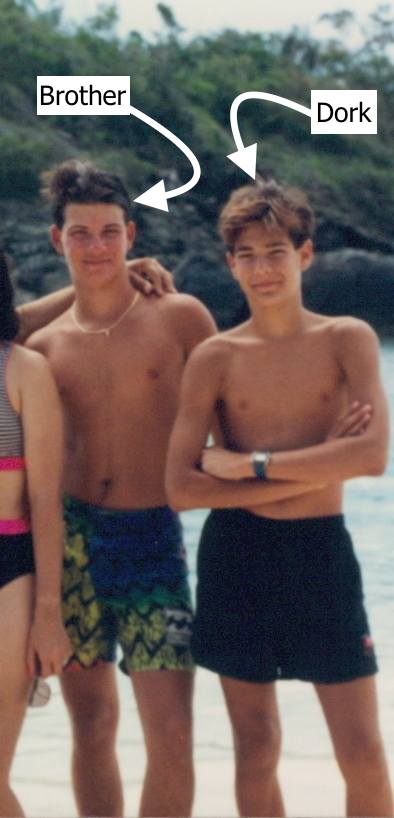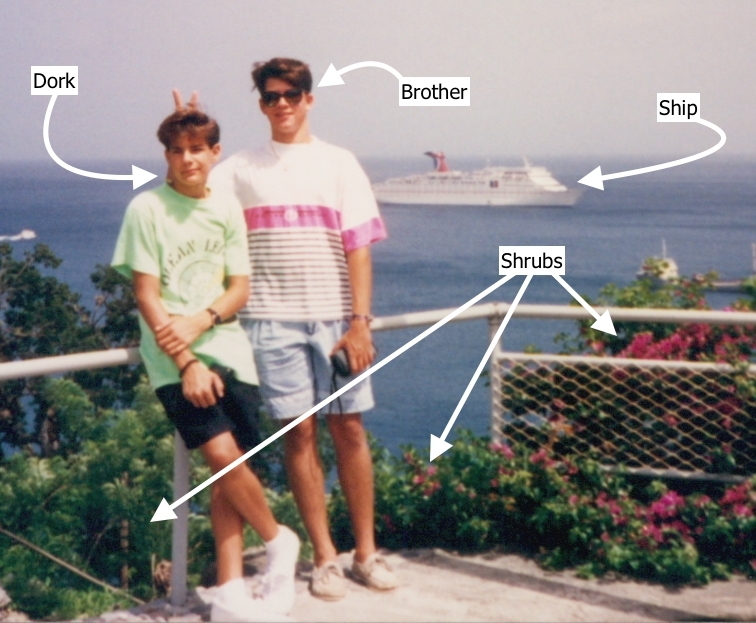Is pain what brought the patient in? Kind of, but not exactly…

Dr. Erik P Meira – Age 14 – Latin America
Many times when I’m discussing placebo and specific effects, physical therapists will say, “The patient doesn’t care. They just want less pain. We should give them less pain even if it’s temporary and the treatment is nothing but a placebo.” Ah, I see. That’s a different argument. You don’t want to talk about whether or not an intervention is a placebo; you are asking a different question from the perspective of patient values. Ok. Let’s head down that road…
DISCLAIMER: I am about to divert to what I feel is an amusing anecdote to set the tone for my ultimate point. If you would like to just skip to that point, follow this asterisk.*
When I was growing up, my family went on a lot of cruise ships. Back in the 1980s, these weren’t the big opulent beasts that they are today. Also, cruises back then were CHEAP. Not only was the port a short drive from our South Florida home, but a family of four could spend a week at sea for under $1000 total which included lodging, food, and transportation from island to island. Well, it was cheap as long as you were willing to sleep in a room below the waterline near the ship’s boiler. Who cared? My brother and I spent every waking hour running around the ship or exploring some unique island culture.

Author and his brother topless on a beach. Author still avoids benchpress exercise…
Good thing I had an older brother. You see, I was a socially awkward kid (REALLY? You don’t say! You? Socially awkward?). My brother would make friends with the other kids on the ship and I would tag along. Although I was very shy, my sense of humor usually made me tolerable on the rare occasion that I would talk. After a day or two, I wouldn’t need my brother anymore.
When I was 14 years old, while on one of these cruises, I was running around the ship with a new group of ship-friends (thanks to my brother). Some of them were actual, real-life, bona fide GIRLS (fully engage awkward tendencies to exponential levels). As we were running around, I had the great idea of cutting through the ship’s dance club as a short cut.

Infographic explaining cruise ship setting
Being 14, we weren’t allowed in the dance club during evening hours, but this was around two in the afternoon so it was empty. In we dart. All the chairs are stacked along the walls but surrounding the dance floor are concentric circles of short metal cocktail tables bolted to the floor. It was also dark in there. As I’m trying to “look cool”, I jump over one of the tables at full speed. I land it in full stride and look over my shoulder at my ship-friends. BONG!!!!!
I feel pain, a lot of pain, in my right shin. Apparently, as I landed my jump, I failed to see the next table. With my next stride at a full sprint, I put my right shin into a metal table that was bolted to the floor. I went down in a heap – the whole time still trying to look cool of course.
*(Welcome back person who skipped that anecdote! You just missed a bunch of hilarity, teenage hijinks, and a series of informative pictures. What you need to know is that I hit my shin really, really hard on a metal table that was bolted to the floor. It hurt.)
In this scenario, I didn’t seek medical attention. But why not? I had pain, plenty of it, and I didn’t like having that pain. So what stopped me from seeking help?
After I whacked my shin, the most obvious concern was that I might have fractured my tibia. I immediately touched my leg. It was very tender and I felt a little “dent” but I had played enough soccer to be familiar with “dents” in the shin. I could see a bruise forming, but no deformity. I put some weight on it and the leg took it without a sharp increase in pain. It was clearly not broken.
The pain was normal and understandable. As a matter of fact, the ABSENCE of pain in that situation would actually be more worrisome. Also, from my quick assessment, I had the knowledge that there was no serious damage (fracture). The pain was just well understood pain from what appeared to be only minor damage. Why WOULD I seek medical attention?
Physical therapists often forget this simple fact and believe every patient wants treatment. Sure, their pain brought them in, but it is not necessarily pain that is the primary concern of that patient in front of you. Their priority is rarely simply, “I hurt. Make the hurt, and ONLY THE HURT, go away.”
Patients usually seek medical care when they have a “thing” that “concerns them” and the first thing that they want to know is whether or not they “should do anything about it”.
For a dermatologist, that “thing” may be a mole or other skin blemish. The patient is worried that this thing (mole) is a sign of tissue damage (like skin cancer) that would likely get worse and turn into something serious and permanent (like death) if ignored.
For physical therapists, that “thing” is usually pain. The patient is worried that this thing (pain) is a sign of tissue damage (like a weakening tendon) that would likely get worse and turn into something serious and permanent (like tendon rupture) if ignored.
Many cases that present to physical therapists are not very serious and can be ignored. Unfortunately, many physical therapists are not answering this question. The question they are answering is, “What treatment can I provide in this situation?” WRONG!!!
Once you perform your assessment, the first thing you need to establish is whether or not the damage is serious (if there is even any tissue damage at all) and whether or not something NEEDS treatment to prevent permanent issues. Then educate the patient on that reality.
Of course, many physical therapists falsely believe pain should never be ignored and human bodies are fragile, stupid systems that will degrade into chaotic and permanent disaster if the slightest “abnormal” finding isn’t “corrected”. These people are tiresome drains on our profession and should be shot. (I’m kidding of course. They should be hanged.)
The one statement I love to say to patients is, “If you can ignore this, you can ignore this.” (Of course I explain to them why I believe this to be true in their case.) For me this usually results in a very happy patient who thanks me and leaves with a spring in their step. When I first started doing that, I was kind of surprised, almost disappointed, with how often they were “all set”.
Of course if there was something other than pain that you believe you should treat, then treat it, but only after the patient understands all of their options (including ignoring it) and the likely prognoses of choosing those options (be honest). They must also understand what the available treatments do and don’t do (again, be honest). You know – INFORMED CONSENT. Remember that thing? With the patient being EXPLICITLY INFORMED and then EXPLICITLY CONSENTING to the intervention? You know, what makes what you do be categorized as TREATMENT and not as ASSAULT. It’s not just a vague line on the intake form.
So you wouldn’t offer them an intervention that would reduce their pain right then and there in the clinic?! You’re a monster!
Of course I would offer something, after I explain what that “something” does and does not do. I would start with options that they can do for themselves like stretches or ice. Why? Because, although the effects are temporary and likely non-specific (which I explicitly tell the patient), the patients can do it to themselves as many times as they want after they leave the clinic. Sure, I could go with clinic-based treatments like electrophysical modalities or hands on interventions but not only are the effects from those treatments also temporary and non-specific, the patient must now wait until their next visit to get it again.
Am I saying that doing one of those interventions to a patient is “wrong”? No, just why would you start there? Also, you don’t need to throw EVERYTHING at the patient. Similar to the way a physician starts by offering least invasive before progressing to most invasive, my opinion is that we should start with active, self-administered interventions before offering clinic dependent options. Of course where we started before all this pain-talk was by providing treatments that actually have a specific effect and make a difference long-term. Keeping in mind that doing nothing, even recommending to do nothing, is often very acceptable as well. It’s up to the patient.
But wait! What if they have persistent (chronic) pain with no remaining tissue damage?!
That’s something different. The evidence for treating that kind of pain is pretty shitty across the board. That gets into self-efficacy (teaching a patient how to take control over their situation themselves) more than anything.
What about the “window of opportunity”???
Ah, that one. Changing the argument again are we? That’s for another time…

The author at age 14, now bored with you…
